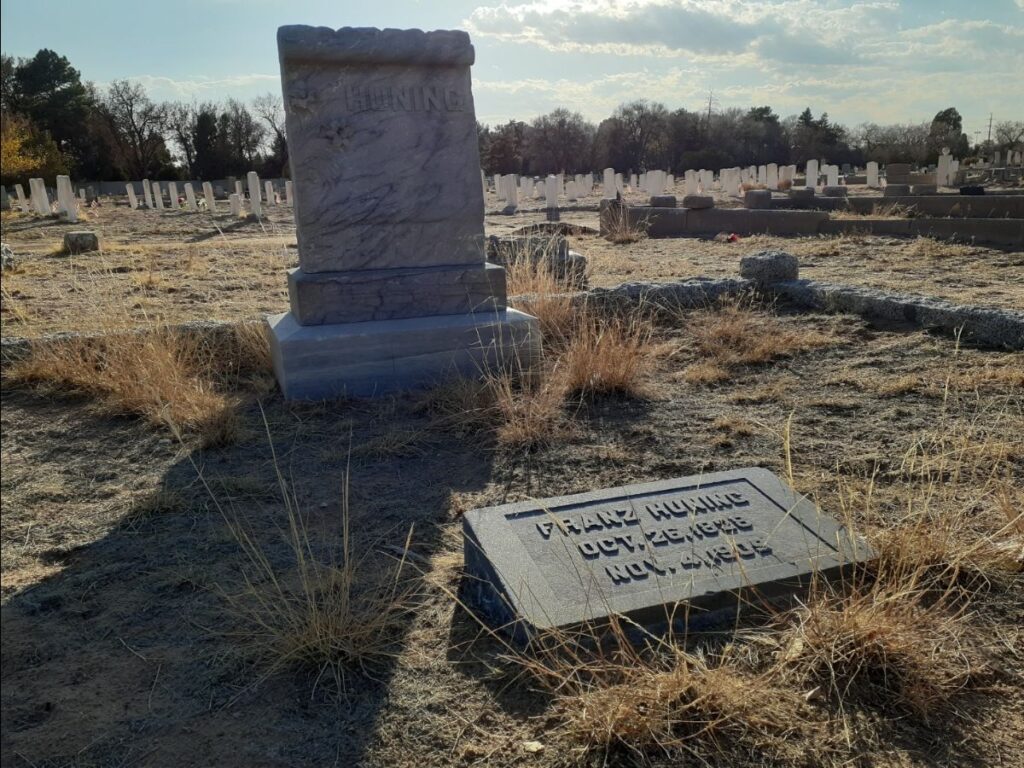
September 9, 2024
The final resting place of the three people who basically created modern Downtown Albuquerque is set to be designated as an official city landmark, a celebration that also ensures future alterations of the property will be subject to city oversight. The Landmarks Commission voted unanimously on August 14 to honor the Historic Fairview Cemetery (Yale and César Chávez), a move that doubles as a recommendation that the City Council follow suit.
The cemetery comprises the older, northern part of what is now called Fairview Memorial Park. The park’s owners, the Daniels family, deeded the 17-acre historic section to a nonprofit in 2020, city historic planner Silvia Bolivar told the panel. Earlier this year, the group’s board asked the commission to recognize the facility as a landmark. It is already listed on the National Register of Historic Places.
The cemetery’s resident Downtown founding trio is composed of businessmen Elias Stover, Franz Huning, and William Hazeldine. In the years just before Albuquerque’s 1880s railroad boom, the three cut a deal with the Atchison, Topeka, and Santa Fe Railway that led to its laying track through what is now the Downtown core. In those days, it was the kind of revolutionary economic break communities around the county were eager to get.
Knowing the railroad was heading their way and looking for routes, the three men had quietly bought 3.1 square miles of land suitable for tracks and railroad facilities. They then deeded the land to an AT&SF subsidiary for $1 plus a share of the profits from sales of any acreage the railroad might sell as surplus. Before long, the AT&SF designated the site as its connection point with the Atlantic and Pacific Railway, which made it the logical choice for a depot, repair yard, and company offices. Thus was born New Town Albuquerque, a separate political entity from the original Albuquerque that grew up around the plaza and would soon be called Old Town.
Huning, having helped create a hot real estate market around the new railroad facilities, took advantage of that by developing what is now the Huning Highlands neighborhood, New Town’s first suburbanesque development. He continued to prosper in business and later built for his family the locally famous Huning Castle at what is now Fifteenth and Central, after which the Huning Castle Neighborhood is named.
Stover, after a varied career as a sea captain, Union Army officer, and Kansas politician, moved to New Mexico in 1876 and later opened a store on the Old Town Plaza. After his initial venture with Huning and Hazeldine, he joined with them in establishing more subdivisions for new housing south of the city center. Stover held state and local elected offices and was UNM’s first president. He died in 1927 at the age of 90. Stover Avenue is named after him.
Hazeldine, an attorney and later judge, also teamed up with Huning on other projects, including organizing the street car company that connected New Town and Old Town, starting a firm that produced coal gas for the city’s streetlamps, and founding a newspaper. His real estate investments included one near what is now Buena Vista Drive SE, which struck many Albuquerque residents at the time as ludicrously far away from the center of things. Hazeldine Avenue is named for him. (Hazeldine, the Albuquerque-based alternative country band that flirted with national fame in the late 1990s, took its name from the street.)
In yet another joint effort, in 1880, Huning, Stover, and Hazeldine founded the cemetery where they now are buried. It was New Town Albuquerque’s first such facility and, in the eyes of many residents, another mark that the city was going places.
Other familiar Greater Downtown names adorning Fairview headstones include William Lovelace (of the hospital), former Mayor Clyde Tingley, Mary Frances McKnight Bezemek (of the Wells Park dairy family), and Oren Strong (of Strong-Thorne Mortuary fame). DAN’s 2021 pictorial gravestone guide is here.
Fairview Cemetery’s layout was influenced by two schools of thought then popular in the Midwest and East Coast, the origin of many New Town residents, according to the planning staff report endorsing landmark designation. The Rural Cemetery Movement envisioned graveyards that visitors would find attractive and meaningful. Fans of the Picturesque Cemetery Movement imagined environments suited for meditation and encounters with nature, which they felt had become close to impossible in booming industrial cities. The cemetery’s pathways, plantings, and monuments were placed with these ideals in mind.
In recent decades, however, the acreage has lost much of its original luster as funds collected through burial fees and set aside for long-term maintenance ran out. Minimal tending and irrigation have led to the loss of much of the lawn and landscaping, and many gravestones have been damaged but not repaired.
At the commission hearing, Susan Drake-Schwartz, the Historic Fairview Cemetery historian and recently elected board president, said her organization has begun drafting a five-year strategic plan for the cemetery. In public comment supporting landmark designation, former Albuquerque Historic Preservation planner Ed Boles said that while Fairview has suffered from neglect, “the pendulum has swung now in a good direction.”
“This is very much a no-brainer,” Commissioner Joe McKinney added just before the landmark status vote. “The founders of the city are certainly there, and some of the families are still around.”
—By David Lee
Further reading on Fairview Historic Cemetery:
- A 2020 New Mexico Magazine article is here.
- A 2014 Alibi article is here.
- A cemetery map and self-guided tour is here.
